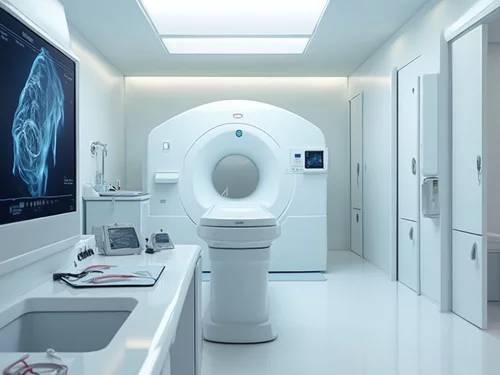In today's healthcare landscape, understanding diagnostic imaging is more critical than ever. With advances in technology and techniques, patients can now take charge of their healthcare decisions. Are you aware of the various imaging tests that can provide crucial insights into your health? Let's explore how these tests can shape your healthcare journey.
What You Will Learn
- Diagnostic imaging encompasses various techniques critical for diagnosing and monitoring health conditions.
- Common imaging tests include X-rays, CT scans, MRI scans, and ultrasounds, each serving unique purposes.
- Understanding these tests can empower you in making informed decisions about your healthcare.
- The role of diagnostic imaging is vital as it bridges the gap between symptoms and accurate diagnoses.
- Consulting with healthcare providers about the most suitable imaging test can enhance your healthcare experience.
Understanding Diagnostic Imaging Tests
A quick overview of the primary diagnostic imaging tests available, highlighting their unique purposes and key applications.
X-ray
Quick and common for assessing bone fractures and certain lung conditions.
CT Scan
Offers detailed images of internal organs, bones, and tissues, ideal for a comprehensive diagnosis.
MRI
Best for evaluating soft tissues, including the brain, muscles, and ligaments (no radiation).
Ultrasound
Safe, real-time imaging, often used during pregnancy or to examine soft tissues and organs.
PET Scans
Advanced imaging for detecting cancer and assessing metabolic activity.
Understanding Diagnostic Imaging: An Overview for Reservoir Residents
As a resident of Reservoir, you may have heard the term diagnostic imaging tossed around during healthcare discussions. But what does it really mean and why should you care? Diagnostic imaging encompasses a range of techniques that help healthcare professionals visualize the inside of your body. This is essential for diagnosing conditions, planning treatments, and monitoring health issues. Understanding these tests can empower you in making informed decisions about your healthcare.
Diagnostic imaging is not just about taking pictures; it plays a crucial role in modern medicine. These tests can uncover issues that aren't visible during a physical examination, leading to earlier diagnoses and, ultimately, better outcomes. With this in mind, let’s delve deeper into what these imaging tests entail.
What Diagnostic Imaging Tests Are and Why They Matter
Diagnostic imaging tests are medical procedures that create images of the internal structures of your body. These images help healthcare providers understand your condition better and guide them in determining the appropriate treatment. Some common imaging tests include:
- X-rays
- CT scans
- MRI scans
- Ultrasound
Each of these modalities serves different purposes and can provide critical information about various health concerns. For instance, X-rays are often used to detect fractures, while MRIs are more effective for soft tissue evaluations. For a comprehensive overview of various diagnostic methods, you can refer to authoritative sources like MedlinePlus on Diagnostic Tests.
Role of Diagnostic Imaging in Modern Healthcare
In today’s healthcare landscape, the role of diagnostic imaging cannot be overstated. It acts as a bridge between symptoms and accurate diagnoses. For example, when you visit a healthcare provider with persistent pain, they may order imaging tests to pinpoint the source of that pain. This not only saves time but also helps avoid unnecessary treatments.
Additionally, many healthcare facilities, including those in Reservoir, are now equipped with advanced imaging technologies, enhancing the accuracy of diagnoses. As you navigate your healthcare journey, it’s important to feel confident about the resources available. Knowing about diagnostic imaging can make a significant difference in your experience. The International Atomic Energy Agency (IAEA) provides further insights into the global importance of diagnostic imaging in disease diagnosis.
Exploring the Main Types of Diagnostic Imaging Tests
Now that we have a foundational understanding of diagnostic imaging, let's explore the main types of tests available. Each type has its unique applications, benefits, and considerations, allowing healthcare providers to choose the best option for each patient's needs.
- X-ray
- CT Scan
- MRI
- Ultrasound
- Specialized Imaging Tests (e.g., PET scans)
This exploration will not only help you understand the differences among these tests but also prepare you for any upcoming imaging procedures you might face.
Did You Know?
According to recent studies, approximately 70% of all medical decisions are based on diagnostic imaging results. This highlights the vital role that imaging tests play in ensuring accurate diagnoses and effective treatment plans. Understanding the significance of these tests can empower you to engage more actively in your healthcare journey. Research from sources like PMC NCBI further emphasizes the impact of diagnostic imaging on medical decision-making.
Frequently Asked Questions About Diagnostic Imaging
Q: What is diagnostic imaging?
A: Diagnostic imaging refers to various medical procedures that create visual representations of the inside of the body. These images help healthcare professionals diagnose, monitor, or treat medical conditions.
Q: What are the most common types of diagnostic imaging tests?
A: The most common types include X-rays, CT scans (Computed Tomography), MRI scans (Magnetic Resonance Imaging), and ultrasounds. Each uses different technology to produce images for specific diagnostic purposes.
Q: Why is diagnostic imaging important in healthcare?
A: Diagnostic imaging is crucial because it allows doctors to see internal structures, helping them identify diseases, injuries, and other conditions that might not be detectable through a physical exam. This leads to more accurate diagnoses and more effective treatment plans.
Q: How do I know which imaging test is right for me?
A: Your healthcare provider will determine the most appropriate imaging test based on your symptoms, medical history, and the specific condition they need to investigate. It's important to discuss all your concerns with your doctor.
Q: Are diagnostic imaging tests safe?
A: While most diagnostic imaging tests are generally considered safe, some involve radiation (like X-rays and CT scans). Healthcare providers always weigh the benefits against the potential risks. MRI and ultrasound do not use ionizing radiation. Discuss any concerns you have with your doctor.
Recap of Diagnostic Imaging Test Options Available in Reservoir
As we navigate the world of diagnostic imaging, it's important for residents of Reservoir to recognize the various options available to them. Every imaging modality serves a unique purpose and can provide crucial insights into your health. Here’s a quick rundown of the primary diagnostic imaging tests you might consider:
- X-ray: Quick and common for assessing bone fractures and certain lung conditions.
- CT Scan: Offers detailed images of internal organs, bones, and tissues, ideal for a comprehensive diagnosis.
- MRI: Best for evaluating soft tissues, including the brain, muscles, and ligaments.
- Ultrasound: Safe, real-time imaging often used during pregnancy or to examine soft tissues and organs.
- PET Scans: Advanced imaging for detecting cancer and assessing metabolic activity.
Each of these modalities has its own strengths and applications, allowing healthcare professionals to make informed decisions tailored to individual patient needs. Understanding these differences can significantly enhance your engagement with healthcare providers.
Key Takeaways About Each Imaging Modality
When considering which imaging test is right for you or a family member, here are some essential takeaways:
- X-rays are typically the first choice for quick assessments.
- CT Scans provide detailed cross-sectional images and are often used in emergency situations.
- MRI scans require no radiation and are excellent for soft tissue evaluation.
- Ultrasound is non-invasive and safe, making it suitable for a variety of applications.
- PET Scans are valuable in oncology, particularly for detecting cancer early.
It's always best to discuss with your healthcare provider which option may be most suitable based on your specific health concerns. They can guide you through the benefits and any potential risks associated with each test.
Encouragement to Consult Healthcare Providers for Personalized Advice
At Reservoir Healthcare Guide, we strongly advocate for proactive communication between patients and healthcare providers. After all, your health is a personal journey! Don’t hesitate to ask questions or express any concerns you might have about diagnostic imaging tests.
Building a strong relationship with your healthcare team ensures that you receive personalized advice tailored to your unique health situation. Remember, you are not alone; we are here to support you in making informed decisions about your healthcare journey!
Recap of Key Points
Here is a quick recap of the important points discussed in the article:
- Diagnostic Imaging Significance: Essential for diagnosing conditions, planning treatments, and monitoring health issues.
- Types of Imaging Tests: Common tests include X-rays, CT scans, MRIs, and ultrasounds, each serving unique purposes.
- Role in Modern Healthcare: Acts as a bridge between symptoms and accurate diagnoses, saving time and avoiding unnecessary treatments.
- Understanding Modalities: Knowing the strengths and applications of each imaging test enhances communication with healthcare providers.
- Consult Healthcare Providers: Always discuss with your healthcare provider which imaging option may be most suitable for your health concerns.










